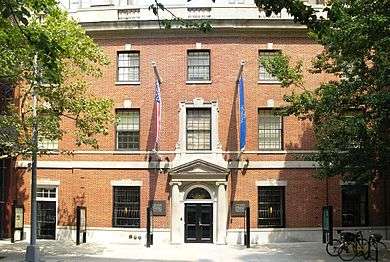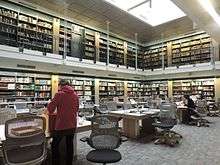Center for Jewish History
The Center for Jewish History is a partnership of five Jewish history, scholarship, and art organizations in New York City: American Jewish Historical Society, American Sephardi Federation, Leo Baeck Institute New York, Yeshiva University Museum, and YIVO Institute for Jewish Research. Together, housed in one location, the partners have separate governing bodies and finances, but collocate resources. The partners' collections make up the biggest repository of Jewish history in the United States. The Center for Jewish History serves as a centralized place of scholarly research, events, exhibitions, and performances. Located within the Center are the Lillian Goldman Reading Room, Ackman & Ziff Family Genealogy Institute and a Collection Management & Conservation Wing. The Center for Jewish History is also an affiliate of the Smithsonian Institution.
History

In 2000, the Center was opened after six years of construction and planning with a goal of creating synergy among the five member organizations, each offering a different approach to Jewish history, scholarship and art.[1] This was one of the first attempts at uniting differing views on Jewish culture[2] and resulted in the largest repository documenting the Jewish experience outside of Israel[3] leading some to refer to it as the Jewish Library of Congress.[4]
In the late 1980s, Bruce Slovin, who was the chairman of YIVO, originated the concept of unified center where the partners could share resources. The idea was triggered when he realized that the then home of YIVO, a mansion located at 86th and Fifth Avenue, was not able to meet the needs of its collections or visitors, resulting in an environment that has hazardous to the collection (it was not temperature-controlled) as well as made archival study difficult. The location on Museum Mile was not seen as an advantageous adjacency. Slovin saw YIVO and the partner organizations as being more academic-focused.[2]
The Leo Baeck Institute was previously located at 129 East 73rd Street, and the American Jewish Historical Society, which had previously been a New York City-based institution prior to the early 1960s, was then located near Brandeis University in Waltham, Massachusetts. The Yeshiva University Museum was located in the Washington Heights neighborhood uptown.[2]
When it opened its doors to the public in October 2000, the Center struggled with financial problems. In 2007, there were preliminary talks about a partnership with NYU's Skirball Department for Hebrew and Judaic Studies to the benefit of both organizations.[5] In the end, the Center and Skirball decided not to move forward. In 2010, the Center for Jewish History was able to raise $30 million to retire its construction debt.[6] The amount was raised and donated by the chairman and founder of the center, Bruce Slovin; co-chairmen William Ackman and Joseph Steinberg; the Fairholme Foundation; and 19 other donors.[7] These efforts meant that the Center was debt-free.[8] In 2012, the Center received a top rating of four stars from the Charity Navigator non-profit evaluation service.[9]
In 2013, the Lillian Goldman Charitable Trust awarded the Center a $1.5 million grant to establish a reference services division.[10][11]
Facilities
The Center is located in Manhattan's Union Square neighborhood, and is a four-building 125,000 square feet (11,600 m2) campus built around a courtyard that has a central entrance on 16th Street. The Center is made up of four previously existing buildings and two new buildings. The buildings are the former location of the American Foundation for the Blind/Helen Keller Institute. The cost of the complex was $4.4 million.[2]
Collections
The partners' collections include more than 100 million documents, 500,000 books, thousands of art objects, textiles, ritual objects, music, films, and photographs.[1][12] most of which had been poorly housed in the member institutions and were at risk of damage or destruction.[13] The Center is heavily involved with the preservation of records that define moments in Jewish immigration to New York City.[14] A $670,000 grant awarded in 2007 helped with the cataloging of these materials.[15]
Partner collection highlights
- Original handwritten copy of Emma Lazarus' 1883 "Give me your tired, your poor" poem that was later inscribed on the base of the Statue of Liberty
- Sandy Koufax's Brooklyn Dodgers jersey
- Letter from Thomas Jefferson to New York's oldest Jewish congregation
- First Hebrew prayer books printed in America[2]
The collections range from the early modern era in Europe and pre-colonial times in the Americas to present-day materials from across the globe. The Center provides access to a comprehensive collection of historic archival materials, including Franz Kafka, Theodor Herzl, Moses Mendelssohn, Sigmund Freud and Albert Einstein.[16] In addition to historical documents like the 1478 record of the trial of Simon of Trent, the Center also includes holdings of artwork by Max Lieberman as well as Jewish ephemera like philosopher Moses Mendelssohn's eyeglasses.[2]
Digital initiatives
- In 2011, Center for Jewish History began a 2-year project called, "Illuminating Hidden Collections at the Center for Jewish History," with a $229,600 grant from the Council on Library and Information Resources[17]
- In 2013, the Center for Jewish History donated 600 images to the Google Art Project, which is part of the Google Cultural Institute, an initiative that puts cultural material online.[18] The Center was one of four New York City-based institutions to donate at that time, joining eight others. The images are very high resolution and include rich metadata.[19][20]
References
- 1 2 Blumenthal, Ralph (26 October 2000). "A Museum Wing To Bear Witness To Jewish Life". The New York Times. Retrieved 31 May 2015.
- 1 2 3 4 5 6 Shepard, Richard F. (28 April 1997). "Archives of Jewish History, Now Under One Roof". The New York Times. Retrieved 31 May 2015.
- ↑ "Affiliate Detail: Center for Jewish History". Smithsonian Affiliations. Retrieved 5 April 2008.
- ↑ Wiener, Julie (24 October 2000). "New History Center Touted As Jewish ‘library of Congress’". Jewish Telegraphic Agency. Retrieved 31 May 2015.
- ↑ Siegel, Jennifer (26 September 2007). "NYU Courts Center for Jewish History". The Jewish Daily Forward. Retrieved 31 May 2015.
- ↑ Strom, Stephanie (21 January 2011). "Finding Deep Pockets to Help a Jewish Center". The New York Times. Retrieved 31 May 2015.
- ↑ Snyder, Tamar (25 January 2011). "History Center In The Black: West 16th Street facility is paid off, thanks to $30 million campaign.". The New York Jewish Week. Retrieved 31 May 2015.
- ↑ Klein, Dan (24 May 2011). "With the Center for Jewish History debt free, its founding chairman steps down". Jewish Telegraphic Agency. Retrieved 31 May 2015.
- ↑ West, Melanie Grayce (24 February 2013). "Family Legacy of Libraries". The Wall Street Journal. Retrieved 31 May 2015.
- ↑ "Center for Jewish History Announces $1.5 Million Grant from The Lillian Goldman Charitable Trust To Establish The Lillian Goldman Reference Services Division". PR Newswire. 29 January 2013. Retrieved 31 May 2015.
- ↑ "An Interview with Michael Glickman of the Center for Jewish History". New Vilna Review. 8 January 2011. Retrieved 31 May 2015.
- ↑ "On 16th and 17th Streets, between Fifth Avenue and Avenue of the Americas; New Center for Jewish History". The New York Times. 15 February 1998. Retrieved 31 May 2015.
- ↑ Bernstein, Nina (9 March 2008). "After a Fight to Survive, One to Succeed". The New York Times. Retrieved 31 May 2015.
- ↑ Center for Jewish History (24 October 2007). "Leon Levy Foundation Awards Additional $860,092 Grant to Center for Jewish History for Preservation of Archival Materials". PR Newswire. Retrieved 31 May 2015.
- ↑ Oster, Marcy (31 January 2011). "Center for Jewish History retires $30 million debt". Jewish Telegraphic Agency. Retrieved 31 May 2015.
- ↑ "2011 Funded Projects: Illuminating Hidden Collections at the Center for Jewish History". Council on Library and Information Resources. Retrieved 31 May 2015.
- ↑ Wire Service (4 April 2013). "NYC center contributes to Google Art Project". North Jersey Media Group. Retrieved 31 May 2015.
- ↑ Herman, Charlie (3 April 2013). "Four New York City Cultural Institutes Join Google Art Project". WNYC. Retrieved 31 May 2015.
- ↑ Haaretz (25 February 2014). "N.Y. Center for Jewish History uploading gigapixel image to Google Art Project". Haaretz. Retrieved 31 May 2015.
External links
| Wikimedia Commons has media related to Center for Jewish History. |








